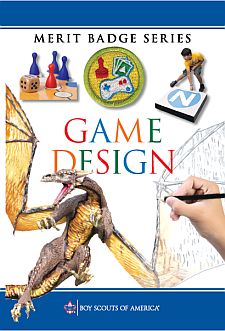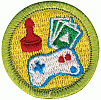- Do the following:
- Analyze four games you have played, each from a different medium. Identify the medium, player format, objectives, rules, resources, and theme (if relevant). Discuss with your counselor the play experience, what you enjoy in each game, and what you dislike. Make a chart to compare and contrast the games.
- Describe five different reasons that people play games. For each, give an example of a game that fits that reason.
- Discuss with your counselor five of the following 17 game design
terms. For each term that you pick, describe how it relates to a specific
game.
- Thematic game elements:
- story,
- setting,
- characters
- Gameplay elements:
- play sequence,
- level design,
- interface design
- Game analysis:
- difficulty,
- balance,
- depth,
- pace,
- replay value,
- age appropriateness
- Related terms:
- single-player vs. multiplayer,
- cooperative vs. competitive,
- turn-based vs. real-time,
- strategy vs. reflex vs. chance,
- abstract vs. thematic
- Thematic game elements:
- Define the term intellectual property. Describe the types of intellectual property associated with the game design industry. Describe how intellectual property is protected and why protection is necessary. Define and give an example of a licensed property.
- Do the following:
- Pick a game where the players can change the rules or objectives (examples: basketball, hearts, chess, kickball). Briefly summarize the standard rules and objectives and play through the game normally.
- Propose changes to several rules or objectives. Predict how each change will affect gameplay.
- Play the game with one rule or objective change, observing how the players’ actions and emotional experiences are affected by the rule change. Repeat this process with two other changes.
- Explain to your counselor how the changes affected the actions and experience of the players. Discuss the accuracy of your predictions.
- Design a new game. Any game medium or combination of mediums is
acceptable. Record your work in a game design notebook.
- Write a vision statement for your game. Identify the medium, player format, objectives, and theme of the game. If suitable, describe the setting, story, and characters.
- Describe the reason that someone would want to play your game.
- Make a preliminary list of the rules of the game. Define the resources.
- Draw the game elements.
- Do the following:
- Prototype your game from requirement 5. If applicable, demonstrate
to your counselor that you have addressed player safety through
the rules and equipment. Record your work in your game design notebook.
You must have your merit badge counselor's approval of your concept before you begin creating the prototype. - Test your prototype with as many other people as you need to meet the player format. Compare the play experience to your descriptions from requirement 5b. Correct unclear rules, holes in the rules, dead ends, and obvious rule exploits. Change at least one rule, mechanic, or objective from your first version of the game, and describe why you are making the change. Play the game again. Record in your game design notebook whether or not your change had the expected effect.
- Repeat 6b at least two more times and record the results in your game design notebook.
- Prototype your game from requirement 5. If applicable, demonstrate
to your counselor that you have addressed player safety through
the rules and equipment. Record your work in your game design notebook.
- Blind test your game. Do the following:
- Write an instruction sheet that includes all of the information needed to play the game. Clearly describe how to set up the game, play the game, and end the game. List the game objectives.
- Share your prototype from requirement 6a with a group of players that has not played it or witnessed a previous playtest. Provide them with your instruction sheet(s) and any physical components. Watch them play the game, but do not provide them with instruction. Record their feedback in your game design notebook.
- Share your game design notebook with your counselor. Discuss the player reactions to your project and what you learned about the game design process. Based on your testing, determine what you like most about your game and suggest one or more changes.
- Do ONE of the following:
- With your parent's or guardian's permission and your counselor's approval, visit with a professional in the game development industry and ask them about their job and how it fits into the overall development process.
- Alternatively, meet with a professional in game development education and discuss the skills they emphasize in the classroom.
Note to the Counselor
The project portion of the Game Design merit badge gives Scouts flexibility to work with a medium of their choosing. The level of effort required to make a game in different mediums can vary significantly. However, the requirements define what each Scout must include in his design notebook so that there is a baseline for all Scouts to meet.
The notebook must demonstrate a thoughtful initial concept, multiple design iterations based on initial testing, and feedback from blind testing. Encourage Scouts to use their notebook to record brainstorming sessions, test parameters, and any game-related ideas throughout the process. Also encourage them to record thoughts behind key design decisions to help them trace and retrace their steps as their designs evolve.
Before a Scout begins the prototyping phase, he must have counselor approval for his design concept. The counselor must make sure that he has put enough effort into the concept phase to have a good foundation for the prototype phase. Watch out for overly ambitious projects that could lead to unnecessary frustration. It is important to understand that the Scout is making a prototype. The challenge of the project is to develop and experiment with gameplay, not to develop extensive programming skills, create beautiful artwork, or spend a lot of time fabricating components.
When prototyping, Scouts should devote most of their energy to assessing and improving the play experience. With each iteration, Scouts should identify game elements that they want to change and how the changes will alter the play experience. After making changes, they then test the game and evaluate whether or not the changes had the desired outcome. It is acceptable for the final prototype to be very different from the initial concept, provided that the notebook shows the progression.
Because the project is so flexible, it is likely that you will have Scouts working in mediums with which you are unfamiliar. The game design community has a vast array of publicly available resources, and the merit badge information online at www.scouting.org maintains updated links to relevant material. If you have a specific concern about programming an electronic game prototype, there are a number of free or inexpensive game design software packages available online. Some are very easy to use with little or no computer knowledge, and most have robust information resources to support them. See the resources section at the end of (the) pamphlet.
The merit badge includes many opportunities for teamwork and group play. Group participation is mandatory to complete requirement 7, but all of the other nonproject requirements also work well in collaboration. Note, though, that each Scout must deliver his own game prototype to complete the project. This ensures that every Scout has the chance to develop and use the critical thinking skills that are part of testing and design iteration. If they want to collaborate on their projects after completing the requirements for the badge they are encouraged to do so, but that is beyond the scope of this badge.
The Game Design merit badge relies heavily on specific terminology. Because game design is broad and game analysis is relatively young, there are few established definitions in the industry. Please refer to the glossary at the end of (the) pamphlet for definitions applicable to the pamphlet and requirements. For additional questions, refer to the merit badge website and the resources listed at the end of the pamphlet.
BSA Advancement ID#:
151
Scoutbook ID#:
140
Requirements last updated in:
2017
Pamphlet Publication Number:
35708
Pamphlet Stock (SKU) Number:
616249
E-Book Stock (SKU) Number:
000000
Pamphlet Copyright Date:
2013
|
|||||||
Page updated on: December 16, 2022









